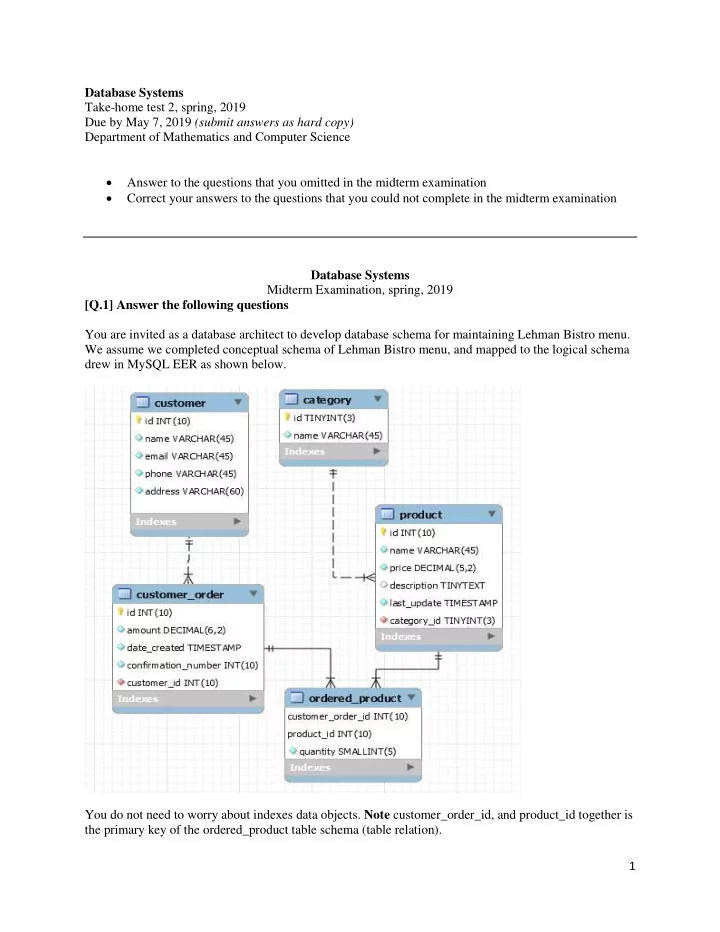

Database Systems Take-home test 2, spring, 2019 Due by May 7, 2019 (submit answers as hard copy) Department of Mathematics and Computer Science Answer to the questions that you omitted in the midterm examination Correct your answers to the questions that you could not complete in the midterm examination Database Systems Midterm Examination, spring, 2019 [Q.1] Answer the following questions You are invited as a database architect to develop database schema for maintaining Lehman Bistro menu. We assume we completed conceptual schema of Lehman Bistro menu, and mapped to the logical schema drew in MySQL EER as shown below. You do not need to worry about indexes data objects. Note customer_order_id, and product_id together is the primary key of the ordered_product table schema (table relation). 1
The following tables show the current state of each table (relation) category table customer table Product table customer_order table ordered_product table a) Explain entity integrity constraint, and show an example b) Explain referential integrity constraint and show two examples c) Explain the difference between solid line connecting two entity types and dotted line connecting two entity types d) Show how to insert a new tuple into the customer table, please note that the customer id is auto generated. e) Write a SQL statement to retrieve customer name, email, and maximum order amount f) Write a SQL statement to list products grouped by each category name g) Write a SQL statement to retrieve at least 3 products in each category from the product table 2
[Q.2] Answer the following questions based on the tennis database schema (a) Write a SQL to create a view that stores all town names from the players table. And write a SQL to retrieve the date from the view (b) Write a SQL statement to retrieve the number of top 3 best players. The best player is defined as the person with highest matches won (c) Write a SQL statement to retrieve 3 lowest penalty amounts from the penalties table (d) MySQL supports UNION operator, so the following SQL works Select playerno From players Union Select playersno From matches MySQL however does not provide intersection operator. Write a SQL statement using temptable (and populate tuple by select statements) to get the intersection of two sets of players. [Q.3] Answer the following questions for a simple library application. The data requirements of the library application are summarized as follows: Design an ER schema for this application, and draw an ER diagram for that schema. Specify key attributes of each entity type and structural constraints on each relationship type. Note any unspecified requirements, and make appropriate assumptions to make the specification complete. BOOK entity is identified by BookId, it has title and multiple author names. PUBLISHER entity consists of Name, Address, and Phone attributes. Name is the key for the PUBLISHER. LIBRARY_BRANCH entity has BranchId as a key and BranchName attribute additionally. Each LIBRARY_BRANCH has one or more copies of the same book. In such a case, noOfCopies attribute needs to be maintained by the relationship type. BORROWER entity has BrowerId as key and additionally has name, address, phone attributes. 3
A book is published by only one publisher. A book can be loaned to a borrower at a specific library branch. a) Draw ER diagram for the conceptual schema of the library database application. Note: you may need to have appropriate assumptions in requirements gathering process in order to make the specification complete. b) Map the conceptual schema to logical database schema. c) Write SQL queries for the following queries on the library database: a. How many copies of the book titled “Database Systems” are owned by the library branch “Lehman”? b. Write a SQL to retrieve the names of all borrowers who checked out any book c. Write a SQL, for each library branch, retrieve the name and the total number of books loaned out from the library branch. [Q.4] Answer the questions based on the following three tables populated in the company database as shown below Employee SSN Fname Lname Works_On 222443333 Jim Brown Essn Pno Hours 333556666 John Aikman 222443333 1 20 456789999 Adam Smith 222443333 2 22 555225555 Rob Scneider 222443333 3 10 333556666 1 15 Project 456789999 6 12 Pname Pnumber Plocation Dnum 555225555 2 20 ProjA 1 Boston 3 555225555 3 10 ProjB 2 NYC 3 ProjC 3 Chicago 3 ProjD 6 Atlanta 2 a) Show data retrieved by the following query SELECT Fname, Lname FROM EMPLOYEE WHERE EXISTS ( SELECT * FROM WORKS_ON WO1 WHERE ( WO1.PNO IN (SELECT PNUMBER FROM PROJECT WHERE DNUM = 3) AND EXISTS (SELECT * FROM WORKS_ON WO2 WHERE WO2.ESSN = SSN AND WO2.PNO = WO1.PNO) ) ); b) Show data retrieved by the following query SELECT Fname, Lname FROM EMPLOYEE WHERE NOT EXISTS ( SELECT * 4
FROM WORKS_ON WO1 WHERE ( WO1.PNO IN (SELECT PNUMBER FROM PROJECT WHERE DNUM = 3) AND EXISTS (SELECT * FROM WORKS_ON WO2 WHERE WO2.ESSN = SSN AND WO2.PNO = WO1.PNO) ) ); c) Show data retrieved by the following query SELECT Fname, Lname FROM EMPLOYEE WHERE EXISTS ( SELECT * FROM WORKS_ON WO1 WHERE ( WO1.PNO IN (SELECT PNUMBER FROM PROJECT WHERE DNUM = 3) AND NOT EXISTS (SELECT * FROM WORKS_ON WO2 WHERE WO2.ESSN = SSN AND WO2.PNO = WO1.PNO) ) ); d) Show data retrieved by the following query SELECT Fname, Lname FROM EMPLOYEE WHERE NOT EXISTS ( SELECT * FROM WORKS_ON WO1 WHERE ( WO1.PNO IN (SELECT PNUMBER FROM PROJECT WHERE DNUM = 3) AND NOT EXISTS (SELECT * FROM WORKS_ON WO2 WHERE WO2.ESSN = SSN AND WO2.PNO = WO1.PNO) ) ); e) Explain difference between left outer join and inner join, write a SQL query to retrieve data by left outer join of Employee and Works_On table f) Write a SQL query to retrieve Dnum to control at least 3 projects 5
Recommend
More recommend